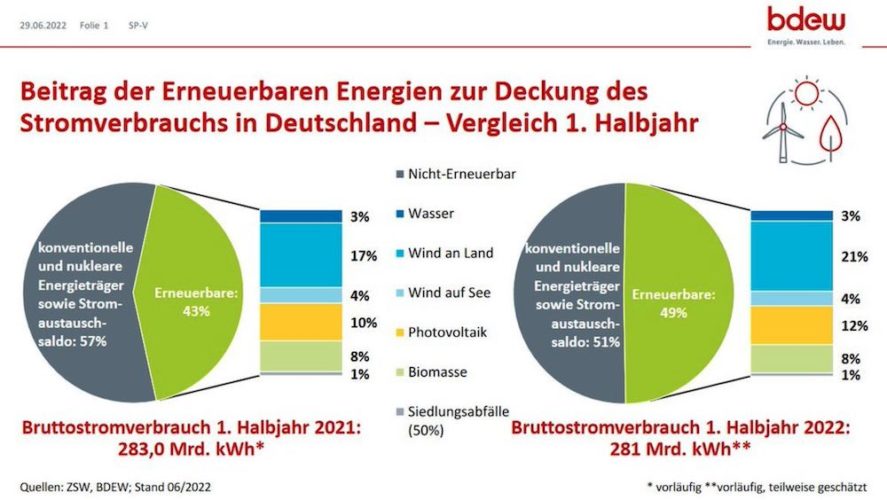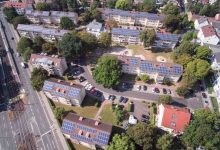Renewable energy has supplied roughly half of Germany’s electricity demand for the first half of 2022, new data has shown, boosting the amount of renewables in the mix by six percentage points compared to the same period in 2021.
Germany’s Center for Solar Energy and Hydrogen Research Baden-Württemberg (ZSW) and the Federal Association of Energy and Water Management (BDEW) said on Monday that renewables had covered around 49% of gross domestic electricity consumption over the period.
In a joint press release, the organisations said that the main contributor to the increased renewables output was a “significant increase” in onshore wind and solar capacity – each generating around one-fifth more electricity than in the same period in 2021.
“This growth is mainly due to a windy start to the year in January and February and numerous hours of sunshine in May and June,” the statement said. “There was also slight growth in offshore wind energy and biomass.”
From a total of 298 billion kilowatt-hours (billion kWh) of generation in the six months, primary calculations show that total of around 139 billion kWh of electricity was generated from the sun, wind and other renewable sources.

Around 59 billion kWh of this came from onshore wind, almost 33 billion kWh from photovoltaics, almost 24 billion kWh from biomass, 12 billion kWh from offshore wind and 9 billion kWh from hydroelectric power, the sources said.
Germany, like Australia, is in the throes of an energy market crisis driven by fossil fuel supply and pricing issues, largely resulting from Russia’s invasion of Ukraine. And, like Australia, Germany is also in the midst of one of the fastest and most ambitious transitions to a net-zero emissions grid.
Just this week the German government proposed an emergency law to allow it to support or even bail out struggling energy companies, and potentially to introduce a special gas price levy that would share the costs of higher import prices between consumers and companies.
But beyond these short-term fixes, Germany’s government well understands that a fast-tracked shift to renewable energy is the best way to avoid crises like this on in the future.
“The declining gas flows from Russia have put the energy supply in Germany in an exceptional situation,” said Kerstin Andreae, chair of the BDEW Executive Board.
“The surest way to avoid such situations in the future is to rapidly expand renewable energies. They are the key to a green power and heat supply, an industry that produces hydrogen and climate-neutral mobility.
“There is an urgent need for action, especially when it comes to expanding wind energy on land. The biggest stumbling block here is still the lack of space,” Andreae said.
Dr Frithjof Staiß, executive director of the ZSW, said that in view of such “obvious” challenges as available space for onshore wind expansion, there should be a greater focus on solar in the European nation.
“Photovoltaics must not be overlooked: With the targeted expansion path to 215 gigawatts of installed capacity in Germany in 2030, an unprecedented annual installation volume of 22 gigawatts per year from 2026 can be achieved.”
Staiß pointed to the dependency on Chinese manufacturers, however, as representing a considerable risk to the realisation of Germany’s ambitious – and vital – solar expansion goals.
To help rememdy this, Staiß called for Germany to actively contribute to launching a so-called Important Project of Common European Interest (IPCEI) for photovoltaics, covering everything from manufacturing processes to recycling, to “re-establish the value chain of photovoltaics in Europe.”
“Because for the same reasons, there are already IPCEIs for batteries and hydrogen, which are also of outstanding strategic importance for climate protection and energy security in Germany Switzerland and Europe,” he said.










